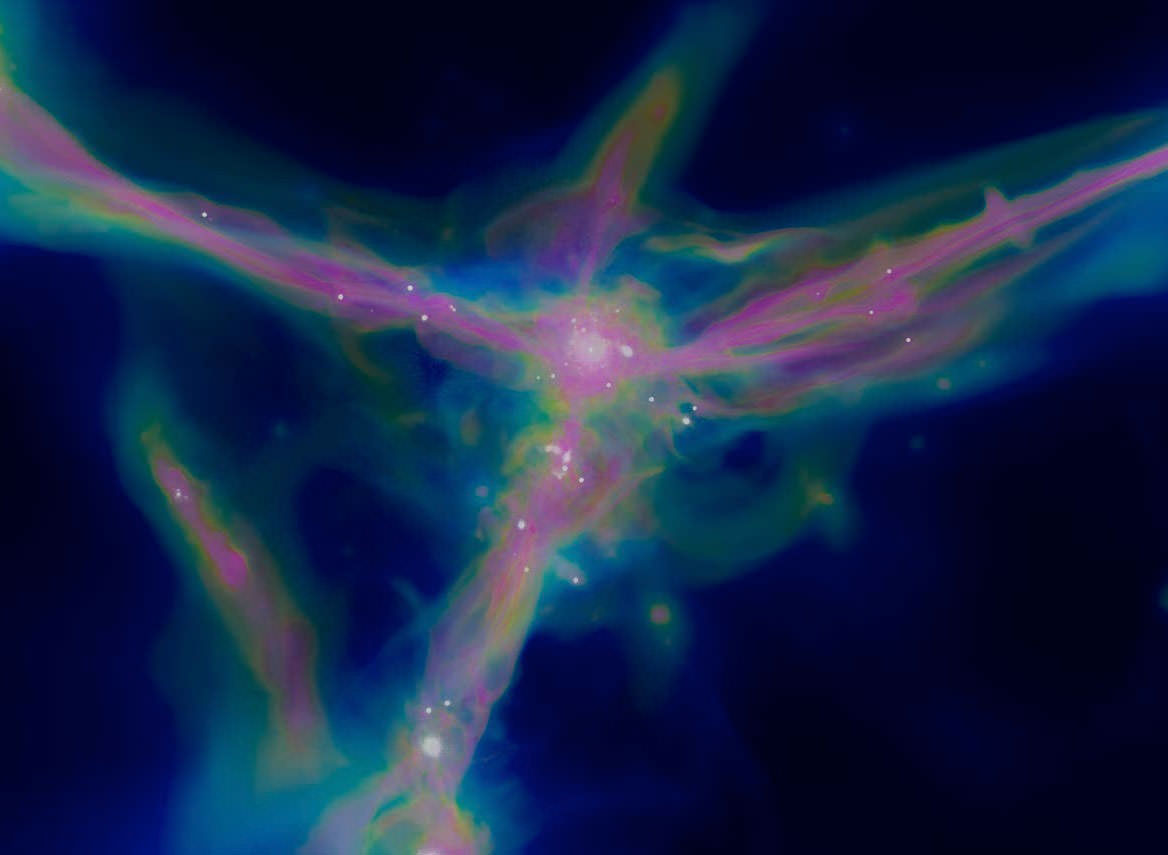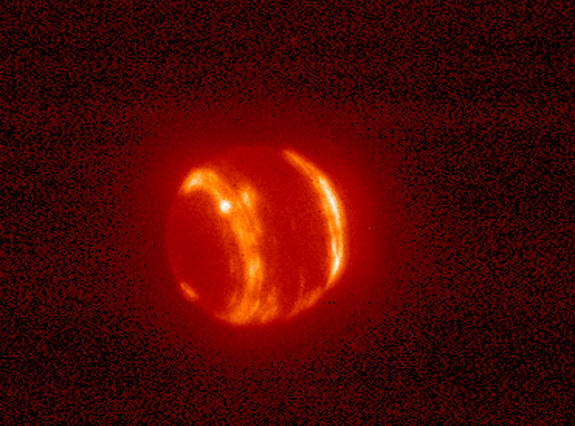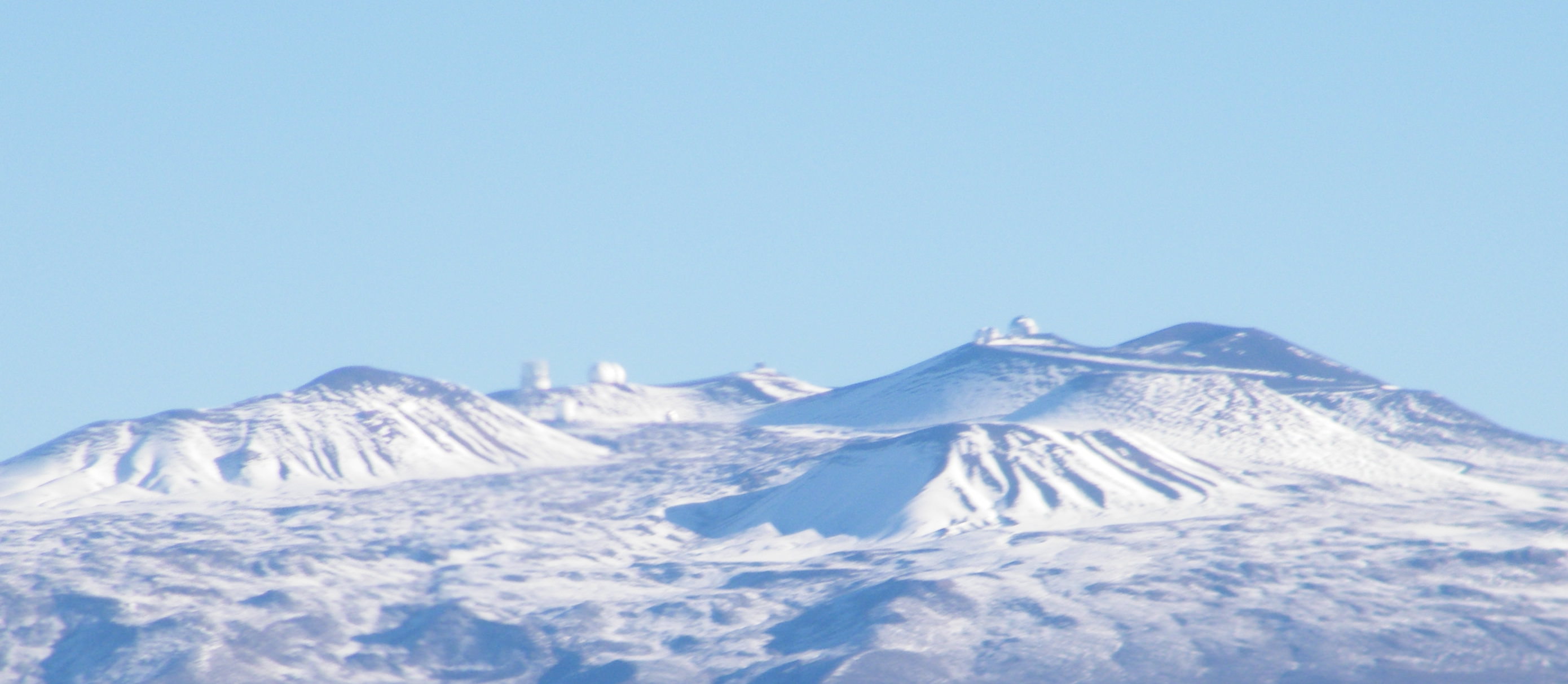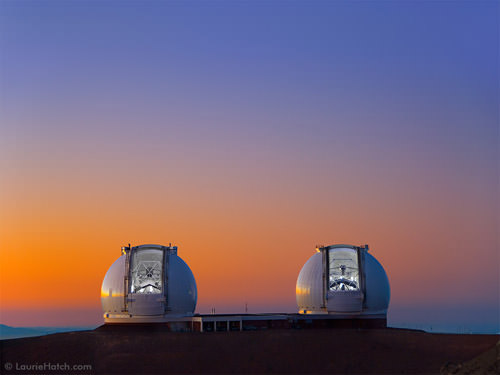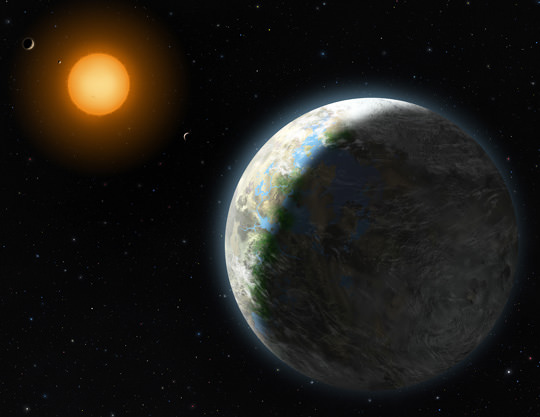Who knew there were so many moving parts to operate a telescope? This is a great behind the scenes video of what really takes place up at the summit of Mauna Kea in Hawaii. About 125 people work full-time at the Keck Observatory to operate the two ten-meter telescopes. The intricate fine-tuning and elaborate attention to detail is amazing. “Keeping those telescopes on-sky every night is the summit crew of the Operations Department. This video is dedicated to the guys of the Keck daycrew who make it possible,” wrote Keck engineer Andrew Cooper, who compiled this unique and must-watch video. He details the techniques he used at his Vimeo page for this video.
Watch Live Webcast from the Keck Observatory
On Thursday, Feb. 9, 2012, Keck Observatory will be hosting a live webcast of an astronomy talk by Dr. Tom Soifer of Caltech, who is the Director of the Spitzer Science Center. The title of the talk is “Seeing the Invisible Universe,” and Soifer will discuss the latest exciting results from NASA’s Spitzer Space Telescope. The webcast begins at 7 pm Hawaiian Time, 9 pm Pacific Time (5 am GMT, Feb 10) and will be streamed from the Kahilu Theatre in Waimea-Kamuela, on the Big Island of Hawaii. Watch in the window above (click the play button) or watch on the Keck website.
Potential ‘Goldilocks’ Planet Found

A new-found planet is in a ‘just-right’ location around its star where liquid water could possibly exist on the planet’s surface. A team of international astronomers have discovered a potentially habitable super-Earth orbiting a nearby star in a habitable zone, where it isn’t too hot or too cold for liquid water to exist. The planet, GJ 667Cc, has an orbital period of about 28 days and with a mass about 4.5 times that of the Earth. The star that it orbits is quite interesting. It is an M-class dwarf star and is a member of a triple star system and appears to be quite different from our Sun, relatively lacking in metallic elements.
The team said this discovery demonstrates that habitable planets could form in a greater variety of environments than previously believed.
“This was expected to be a rather unlikely star to host planets,” said Steven Vogt from UC Santa Cruz, one of the scientists involved in the discovery. “Yet there they are, around a very nearby, metal-poor example of the most common type of star in our galaxy. The detection of this planet, this nearby and this soon, implies that our galaxy must be teeming with billions of potentially habitable rocky planets.”
“This planet is the new best candidate to support liquid water and, perhaps, life as we know it,” said Guillem Anglada-Escudé, from the University of Gottingen in Germany. He was with the Carnegie Institute for Science when the planet was first discovered.
The planet orbits quite close to its parent star at 0.12 astronomical units, which is much closer than Mercury to the Sun. However, the Planetary Habitability Laboratory says the star is much dimmer and provides enough energy for the planet to possibly maintain similar terrestrial temperatures. There’s a caveat, though, that astronomers aren’t sure what the planet’s composition is, because they have not been able to measure its size; therefore, it could be a either a rocky or a gas planet. I would need to have a radius between about 1.7 and 2.2 Earth radii to be a rocky world.
The team used public data from the European Southern Observatory combined with observations from the Keck Observatory in Hawaii and the new Carnegie Planet Finder Spectrograph at the Magellan II Telescope in Chile. To follow up and verify the findings, the team used the radial velocity method to measures the small wobbles in the star’s motion caused by the gravitational tug of a planet.
“With the advent of a new generation of instruments, researchers will be able to survey many M dwarf stars for similar planets and eventually look for spectroscopic signatures of life in one of these worlds,” said Anglada-Escudé.
The star, GJ 667C is 22 light years away. It has much lower abundance of elements heavier than helium, such as iron, carbon, and silicon, as does our Sun. The other two stars (GJ 667A and B) are a pair of orange K dwarfs, with a concentration of heavy elements only 25% that of our Sun’s. Such elements are the building blocks of terrestrial planets so it was thought to be unusual for metal-depleted star systems to have an abundance of low mass planets.
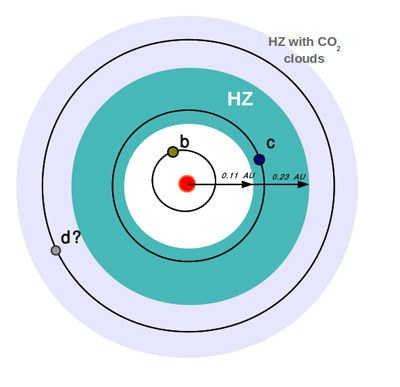
GJ 667C had previously been observed to have another super-Earth (GJ 667Cb) with a period of 7.2 days, although this finding was never published. This orbit is too tight, and thus hot, to support life. The new study started with the aim of obtaining the orbital parameters of this super-Earth, and came to find an additional planet.
The new planet receives 90% of the light that Earth receives. However, because most of its incoming light is in the infrared, a higher percentage of this incoming energy should be absorbed by the planet. When both these effects are taken into account, the planet is expected to absorb about the same amount of energy from its star that the Earth absorbs from the Sun. This would allow surface temperatures similar to Earth and perhaps liquid water, but this extreme cannot be confirmed without further information on the planet’s atmosphere.
The team said there is a possibility of other planets in the system, potentially a gas-giant planet and an additional super-Earth with an orbital period of 75 days. However, further observations are needed to confirm these two possibilities.
This is the fourth potentially habitiable extrasolar planet. Three were found in 2011: Gliese 581d, which scientists say is likely a rocky world about 20 ight-years away; HD 85512 b, another planet orbiting in a habitable zone is about 36 light-years away from Earth; and Kepler 22b, about 600 light-years away. Vogt was involved in the discovery of another planet in 2010 (Gliese 581g) in which he said the “chances of life on this planet are 100%,” but other astronomers have cast doubt on whether that planet even exists.
Papers:
The HARPS search for southern extra-solar planets XXXI. The M-dwarf sample, and A planetary system around the nearby M dwarf GJ 667C with at least one super-Earth in its habitable zone (will add link when it becomes available)
Sources: UC Santa Cruz, Carnegie Institute for Science, Planetary Habitability Laboratory
A Star-Making Blob from the Cosmic Dawn

[/caption]
Looking back in time with some of our best telescopes, astronomers have found one of the most distant and oldest galaxies. The big surprise about this blob-shaped galaxy, named GN-108036, is how exceptionally bright it is, even though its light has taken 12.9 billion years to reach us. This means that back in its heyday – which astronomers estimate at about 750 million years after the Big Bang — it was generating an exceptionally large amount of stars in the “cosmic dawn,” the early days of the Universe.
“The high rate of star formation found for GN-108036 implies that it was rapidly building up its mass some 750 million years after the Big Bang, when the Universe was only about five percent of its present age,” said Bahram Mobasher, from the University of California, Riverside. “This was therefore a likely ancestor of massive and evolved galaxies seen today.”
An international team of astronomers, led by Masami Ouchi of the University of Tokyo, Japan, first identified the remote galaxy after scanning a large patch of sky with the Subaru Telescope atop Mauna Kea in Hawaii. Its great distance was then confirmed with the W.M. Keck Observatory, also on Mauna Kea. Then, infrared observations from the Spitzer and Hubble space telescopes were crucial for measuring the galaxy’s star-formation activity.
“We checked our results on three different occasions over two years, and each time confirmed the previous measurement,” said Yoshiaki Ono, also from the of the University of Tokyo.
Astronomers were surprised to see such a large burst of star formation because the galaxy is so small and from such an early cosmic era. Back when galaxies were first forming, in the first few hundreds of millions of years after the Big Bang, they were much smaller than they are today, having yet to bulk up in mass.
The team says the galaxy’s star production rate is equivalent to about 100 suns per year. For reference, our Milky Way galaxy is about five times larger and 100 times more massive than GN-108036, but makes roughly 30 times fewer stars per year.
Astronomers refer to the object’s distance by a number called its “redshift,” which relates to how much its light has stretched to longer, redder wavelengths due to the expansion of the universe. Objects with larger redshifts are farther away and are seen further back in time. GN-108036 has a redshift of 7.2. Only a handful of galaxies have confirmed redshifts greater than 7, and only two of these have been reported to be more distant than GN-108036.
About 380,000 years after the Big Bang, a decrease in the temperature of the Universe caused hydrogen atoms to permeate the cosmos and form a thick fog that was opaque to ultraviolet light, creating what astronomers call the cosmic dark ages.
“It ended when gas clouds of neutral hydrogen collapsed to generate stars, forming the first galaxies, which probably radiated high-energy photons and reionized the Universe,” Mobasher said. “Vigorous galaxies like GN-108036 may well have contributed to the reionization process, which is responsible for the transparency of the Universe today.”
“The discovery is surprising because previous surveys had not found galaxies this bright so early in the history of the universe,” said Mark Dickinson of the National Optical Astronomy Observatory in Tucson, Ariz. “Perhaps those surveys were just too small to find galaxies like GN-108036. It may be a special, rare object that we just happened to catch during an extreme burst of star formation.”
Sources: Science Paper by: Y. Ono et al., Subaru , Spitzer Hubble
Keck Observatory Locates Two Clouds Of Pristine Gas From The Beginning of Time
[/caption]
Is there any place in space which hasn’t been affected by time? The answer is yes. Thanks to some very awesome research, the W. M. Keck Observatory and a team of scientists have recently located two clumps of primordial gas which may very well have had its origin within minutes of the Big Bang.
How do we know these gas clouds are so special? In this case, they are simply too disseminated to enable stellar birth and contain no heavy metals which would support it. These diaphanous regions are pure hydrogen and helium… along with a heavier isotope, deuterium. This combination could mean the two billion year old regions are pure – never involved in the star-forming process. An exciting discovery? You bet. The clouds could have possibly survived in an unchanged state – giving us a look at what may have occurred at the dawn of time.
“Despite decades of effort to find anything metal-free in the universe, Nature has previously set a limit to enrichment at no less than one-thousandth that found in the Sun,” said astronomer J. Xavier Prochaska of the University of California Observatories-Lick Observatory, U.C. Santa Cruz. “These clouds are at least 10 times lower than that limit and are the most pristine gas discovered in our universe.”
Prochaska is part of the Keck team and has coauthored a paper reporting on the discovery with Michele Fumagalli of the U.C. Santa Cruz and John O’Meara of Saint Michael’s College in Vermont. “We’ve searched carefully for oxygen, carbon, nitrogen and silicon – the things that are found on Earth and the Sun in abundance,” Fumagalli said. “We don’t find a trace of anything other than hydrogen and deuterium.”
According to the Keck Observatory news release exactly how they can detect dark, cold, diffuse gas about 12 billion light-years away is a story in itself.
“In this case we actually have to do a bit of a trick,” Prochaska explained. “We study the gas in silhouette.” A more distant quasar provides the light for this. The quasar light shines though the gas and the elements in the gas absorb very specific wavelengths of light, which can only be found by splitting the light into very detailed spectra to reveal the dark lines of missing light.
In other words, said Fumagalli, “All of the analysis is on the light we didn’t get.” The clouds absorb only a small fraction of the quasar light that makes it to Earth. “But the signatures of hydrogen absorption are obvious, so there’s no doubt there’s a lot of gas there.”
While some folks might not get excited over the location of immaculate gases, astronomers think differently. This revelation supports their theories of what may have occurred within moments after the Big Bang and what formed at the time of nucleosynthesis. It’s a look back at when hydrogen, helium, lithium and boron originated.
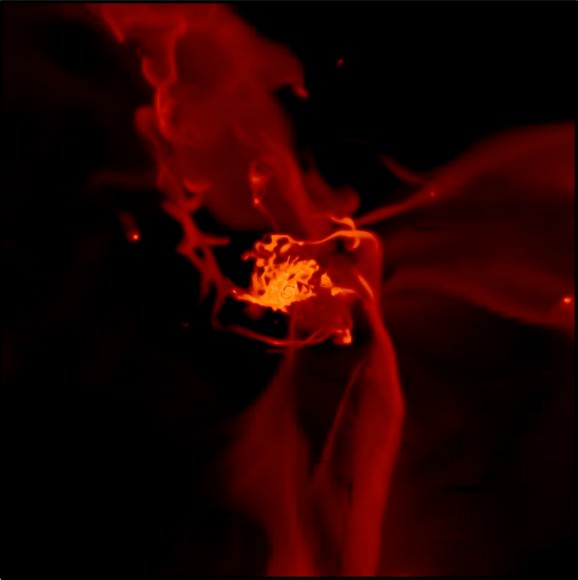
“That theory has been very well tested at Keck as regards to hydrogen and its isotope deuterium,” said O’Meara. “One of the conundrums of that previous work, however, is that the gas also showed at least trace amounts of oxygen and carbon. The clouds that we have discovered are the first to match the full predictions of BBN.”
What’s more, Keck’s two 10-meter optical/infrared telescopes have shown us what the early universe may have been like. This is the very first time that science has been able to peer into regions where no metals have influenced the environment and no stars have formed.
“What excites me about this discovery is that there is an almost a range of 1,000,000 in the metallicity in gases at that time in the universe,” said Fumagalli. In other words, there were places like our Solar system – where metals are very abundant – and there were also places very unlike today, where metals were still virtually non-existent and the gases were unchanged since almost the beginning of time.”
Original Story Source: Keck Observatory News Release. For Further Reading: Detection of Pristine Gas Two Billion Years After the Big Bang.
“Baby” Planet Caught in the Act of Forming
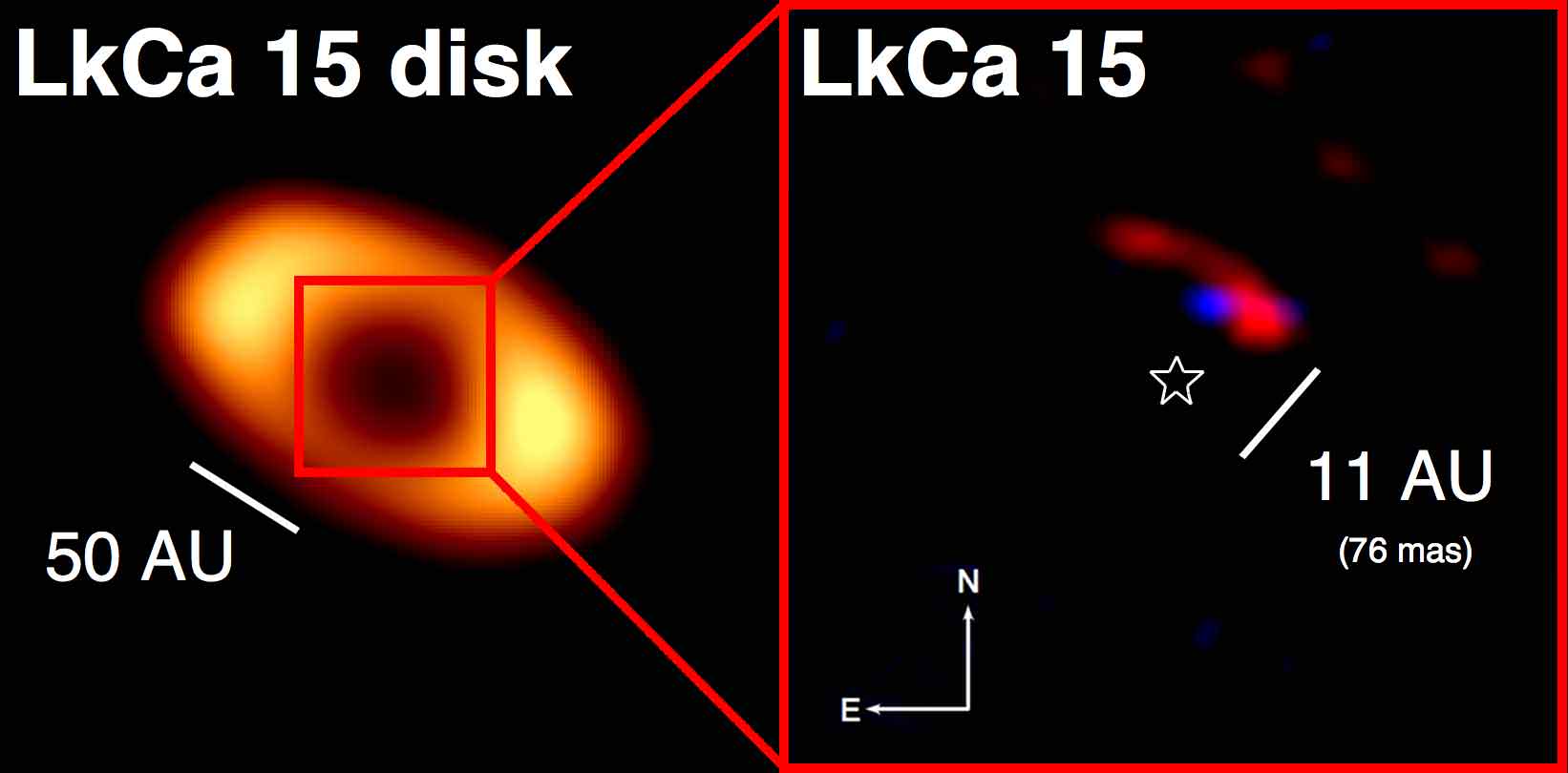
[/caption]
Astronomers have taken a step closer to finding out how planetary systems form with the discovery of the ‘youngest’ planet ever found. LkCa 15 b is so young, it is still in the act of forming. This is the first direct image of a planet in the process of forming, and data indicates the planet is still being pieced together by gas and dust falling into its clutches from a cooler envelope that surrounds it.
The hot protoplanet orbits a star which possesses a mass comparable to our Sun, and is the youngest planetary system ever to be identified, with LkCa 15 aged at 2 million years, “We really have the age of the star and not the planet,” said Michael Ireland, a lecturer in astrophotonics at the Australian Astronomical Observatory. “The age of the star was determined by a great many people studying the gravitational contraction of both LkCa 15 and all of the other stars in the Taurus star forming region, which formed at nearly the same time.”
The observations were made by astronomers from the University of Hawaii and the Australian Astronomical Observatory using the keen eyesight of the twin 10-metre Keck telescopes located on the summit of Hawaii’s dormant Mauna Kea volcano.
For decades, astronomers have been aware that many young stars that pepper the Universe are shrouded by clouds of gas and dust. And since this realization they have enlisted the help of powerful infrared space observatories such as NASA’s Spitzer Space Telescope to peer into dusty cosmic regions that are hidden from optical telescopes.
Until now scientists had not been lucky enough to capture observations of new planets forming around these young stars, but thanks to the trickery of adaptive optics combined with ‘aperture mask interferometry’ that allows astronomers to resolve discs of dust around stars without the hindrance of dazzling starlight, imaging LkCa 15 b became possible. “It’s like we have an array of small mirrors,” said Adam Kraus of the University of Hawaii’s Institute for Astronomy. “We can manipulate the light and cancel out distortions.”
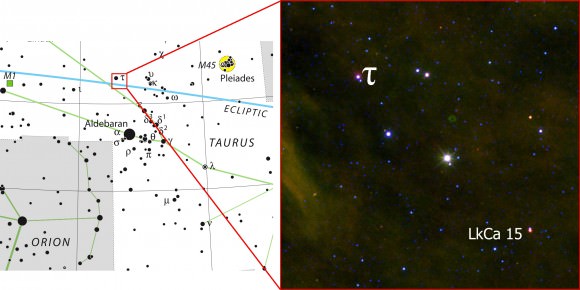
The astronomers have made the clever technique operable since 2008, which allowed them to search for gaps between stars and their protoplanetary dust discs where they figured planets are most likely to be lurking. In 2009 they were rewarded for their efforts as LkCa 15 b presented itself hugging its star, still bright from the energy of its formation. “LkCa 15 was only our second target and we immediately knew we were seeing something new,” said Kraus. “We could see a faint point source near the star, so thinking it might be a Jupiter-like planet we went back a year later to get more data.”
This hot, young world provides a view of the hellish birth of nascent planets.
“The protoplanet is heated up by its gravitational contraction energy,” said Ireland. “Gravitational potential energy is enough to make a truck’s brakes really hot when it goes down a mountain too fast. The potential energy of an entire planet being dropped onto itself is enough to make it glow red hot for millions of years. The planet is more than 1000 degrees Celsius – measuring its temperature more accurately is one of our goals next year. The dust and gas is mostly heated by the radiation field of the star and planet, and in equilibrium, reaches a temperature of less than 100 kelvins [-170 degrees Celsius].”
However, as the young planet pulls in more gas and dust onto itself, the astronomers can only guess as to how big this distant world could get. “The large outer disc around LkCa 15 still has about 55 Jupiter masses of material left in it,” said Ireland. “It is very difficult to estimate just how much of this material could end up on LkCa 15 b. If the orbit is nearly circular, and there is only one planet, then I believe that only a very small fraction of this matter could end up as part of LkCa 15 b. If I had to guess, I’d say around 10 times the mass of Jupiter for a final mass, with a little orbital migration to a closer orbit. However, we’ll get a better idea on this over the coming years with new theoretical models and after we see more of the orbit of the planet.”
The team’s paper can be found here.
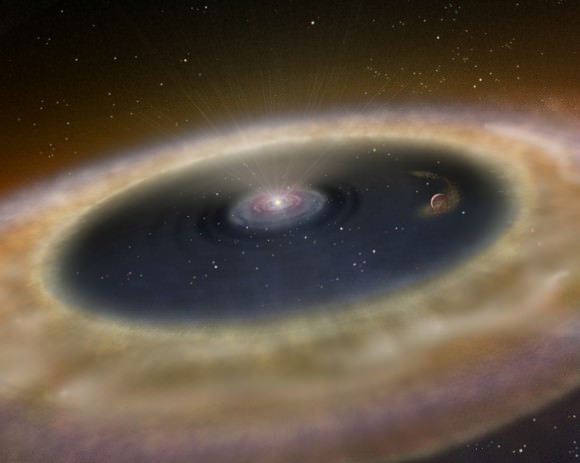
“Pluto-Killer” Sets Sights on Neptune
[/caption]
The confessed (and remorseless) “Pluto Killer” Mike Brown has turned his gaze – and the 10-meter telescope at the Keck Observatory in Hawaii – on Neptune, our solar system’s furthest “official” planet. But no worries for Neptune – Mike isn’t after its planetary status… he’s taken some beautiful infrared images instead!
Normally only visible as a featureless blue speck in telescopes, Brown’s image of Neptune — along with its largest moon Triton — shows the icy gas giant in infrared light, glowing bright red and orange.
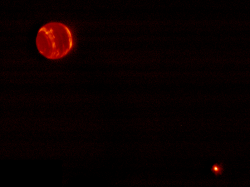
Brown’s initial intention was not just to get some pretty pictures of planets. The target of the imaging mission was Triton and to learn more about the placement of its methane, nitrogen and seasonal frosts, and this sort of research required infrared imaging. Of course, Neptune turned out to be quite photogenic itself.
“The big difference is doing the imaging in the infrared where methane absorbs most of the photons,” said Brown. “So the bright places are high clouds where the sunlight reflects off of them before it had a chance to pass through much of the atmosphere. Dark is clear atmosphere full of methane absorption.
“I just thought it was so spectacular that I should post it.”
No argument here, Mike!
Neptune, now officially the outermost planet in our solar system, is the fourth largest planet and boasts the highest wind speeds yet discovered — 1,250 mph winds scream around its frigid skies! Like the other gas giants Neptune has a system of rings, although nowhere near as extravagant as Saturn’s. It has 13 known moons, of which Triton is the largest.
With its retrograde orbit, Triton is believed to be a captured Kuiper Belt Object now in orbit around Neptune. Kuiper Belt Objects are Mike Brown’s specialty, as he is the astronomer most well-known for beginning the whole process that got Pluto demoted from the official planet list back in 2006.
Read more on Skymania.com here.
_______________
Jason Major is a graphic designer, photo enthusiast and space blogger. Visit his website Lights in the Dark and follow him on Twitter @JPMajor or on Facebook for the most up-to-date astronomy awesomeness!
Behind the Scenes at the Keck Observatory
[/caption]
For about 300 nights out of the year, Mauna Kea on the Big Island of Hawaii is one of the best places in the world for ground-based astronomy. At an elevation of 4,205 meters (13,796 ft), the summit sits above a large portion of the Earth’s atmosphere, and usually, the sky is clear, calm and dry. Indeed, 13 giant telescopes sit Mauna Kea’s summit, and they have made some of the biggest discoveries in astronomy. But for the remaining nights of the year, a variety of weather-related issues can keep astronomers from observing, and visitors from climbing to the summit to see those pristine skies for themselves, as well as being able to watch some of our biggest eyes on the skies action. Sometimes clouds, high winds or humidity might keep the telescope domes closed, other times snow can close the roads. On a recent visit to Hawaii, heavy snow kept the roads closed for three days and my long-planned trip to the top of Mauna Kea was, disappointingly, scrubbed. But I did get a great behind the scenes tour of the W. M. Keck Observatory headquarters in Waimea.

While the telescopes are up at at the top of the mountain, astronomers seldom actually work at the telescopes themselves. Instead they work out of remote operations offices at the headquarters in Waimea. There is an operations room for each of the twin 10-meter Keck telescopes: Remote Operations 1 works the Keck 1 telescope:

And Remote Operations 2 works Keck 2:
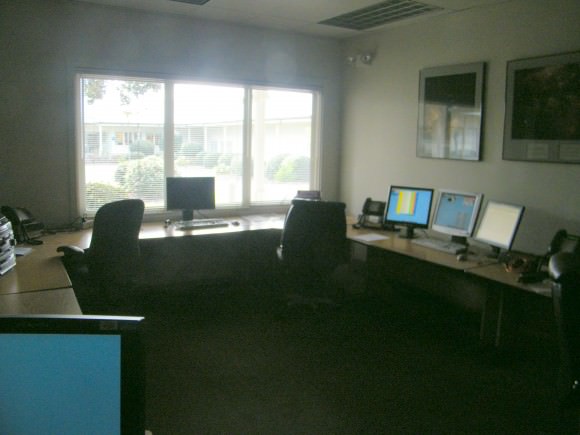
I arrived in the morning before any of the astronomers were there. “People who work for Keck help the visiting astronomers,” said Alexandra Starr, who works with the media and is a public information officer at the Keck headquarters. “Usually, the visiting astronomers start filtering in about 2 o’clock, and the people who work on the summit get things ready for what the astronomers want to observe. There is a camera for those down here to view how things are going for getting the telescope pointed exactly where they want it.”
But the domes on the telescope can’t be opened until the sun goes down.
“So, once they get everything set up, they go for an early dinner and then come back here and observe all night long,” said Starr. “We do have people working around the clock, however. For astronomers who have been here before, sometimes they don’t need a lot of assistance, but our support astronomers will help all the visiting astronomers get the best observing they can, and get the information they need while they are on the sky.”
About 125 people work full-time at Keck, of which two-thirds are local people from from Hawaii. With an annual operating budget of $11 million, the Observatory is one of the town’s largest employers.
At the headquarters, there are condos where the visiting astronomers can stay:

Most astronomers have just two nights for observing, and Starr said it can be up to a year and a half from when astronomers submit a proposal to use the Keck telescopes to when they actually get to observe. But sometimes, depending on the astronomer and what they are observing, they’ll get to return again fairly quickly when the weather doesn’t allow for observing.
“The past 2 nights we haven’t been observing, and those people are in town ready to go,” Starr said.

The backside of facilities includes the observatory’s own mechanics shop. “We have eight 4-wheel drive automobiles to get to the summit, and our own mechanic shop to keep them all in top shape,” Starr said.
The Keck Observatory’s headquarters in Waimea is open to visitors, and volunteer guides are available Tuesday through Friday from 10 a.m. to 2 p.m. to share information about Keck and the other Mauna Kea observatories. The visitor’s center also has a conference room for public lectures from visiting astronomers.
Inside are models and images of the twin 10-meter Keck telescopes:
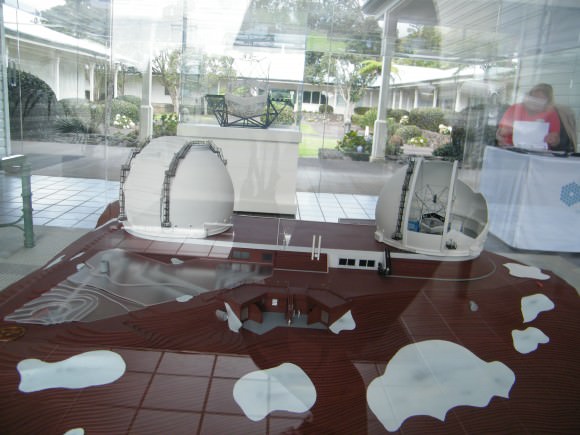
The twin Keck telescopes are the world’s largest optical and infrared telescopes. Each telescope stands eight stories tall, weighs 300 tons and operates with nanometer precision. The telescopes’ primary mirrors are 10 meters in diameter and are each composed of 36 hexagonal segments that work in concert as a single piece of reflective glass.
Outside in the visitor center courtyard is a grassy area that represents the size of just one of the hexagonal segments, which are 1.8 meters (6 ft) in diameter.

Each segment weighs .5 metric tons (880 pounds), and are three inches thick. They are made of a glass and ceramic composite called Zerodur. Zerodur itself is not reflective, so they are covered with a thin reflective layer of aluminum.
“While the telescope is actually working it is constantly fine tuning the position of the individual mirrors to make sure they are all in alignment,” said our tour guide Rosalind Redfield.
On the telescope, each segment’s figure is kept stable by a system of extremely rigid support structures and adjustable warping harnesses. During observing, a computer-controlled system of sensors and actuators adjusts the position of each segment – relative to the neighboring segment – to an accuracy of four nanometers, about the size of a few molecules, or about 1/25,000 the diameter of a human hair. This twice-per-second adjustment effectively counters the tug of gravity.
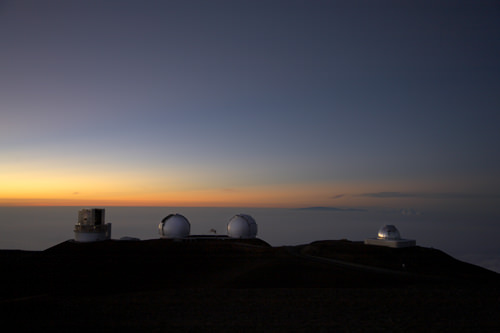
Up at the summit, (which I can only share pictures provided by the Keck Observatory) Redfield said it is like the other side of the Moon. “Absolutely nothing grows up there, the elevation is so high it is completely barren,” she said. “There is fine, sandy type dirt, and they don’t like people driving up there as it stirs up dust. The paved road only goes so far, and anyone driving at the summit creates enough dust that it can cause a problem, and people are only allowed to drive up if you have a four-wheel drive.”
The sun sets on Mauna Kea as the twin Kecks prepare for observing. Credit: Laurie Hatch/ W. M. Keck Observatory
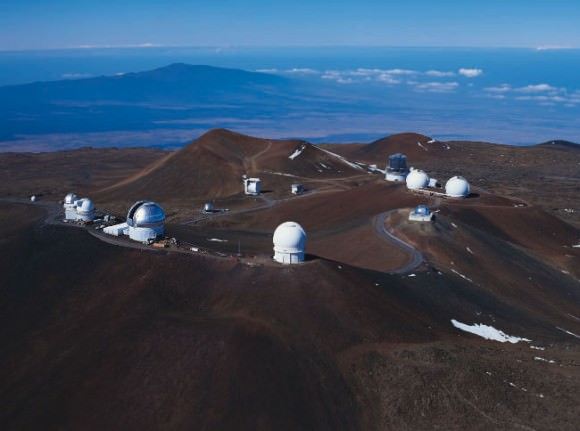
The two Keck telescopes and the 8.3 meter Subaru telescopes take the very top of the mountain. They are joined by the 8.1 Gemini North Telescope , the 0.6-m educational telescope, from the University of Hawaii at Hilo, a 2.2-m telescope University of Hawaii Institute for Astronomy, the 3 meter NASA Infrared Telescope Facility, the 3.6 meter Canada-France-Hawaii Telescope, the 3.8 meter UKIRT (United Kingdom Infrared Telescope), the 10.4 Caltech Submillimeter Observatory, the 15 meter James Clerk Maxwell Telescope, the 8X6 meter Submillimeter Array and the 25 meter Very Long Baseline Array.
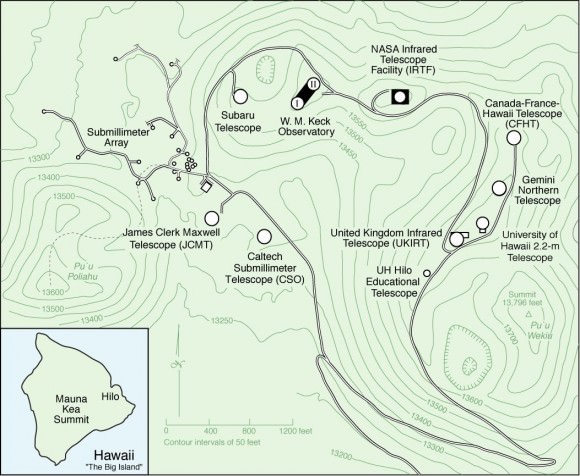
But, no climb to the summit for me — not this time anyway! I hope to return one day to Mauna Kea to see first-hand where science and nature come together to allow for continued discovery of our universe.

For more information about the Keck Observatory, see their website, and if you are in Hawaii or going to be visiting the Big Island, find information here on how you can visit the Observatory headquarters, or go to the summit.
First Four Exoplanet System Imaged
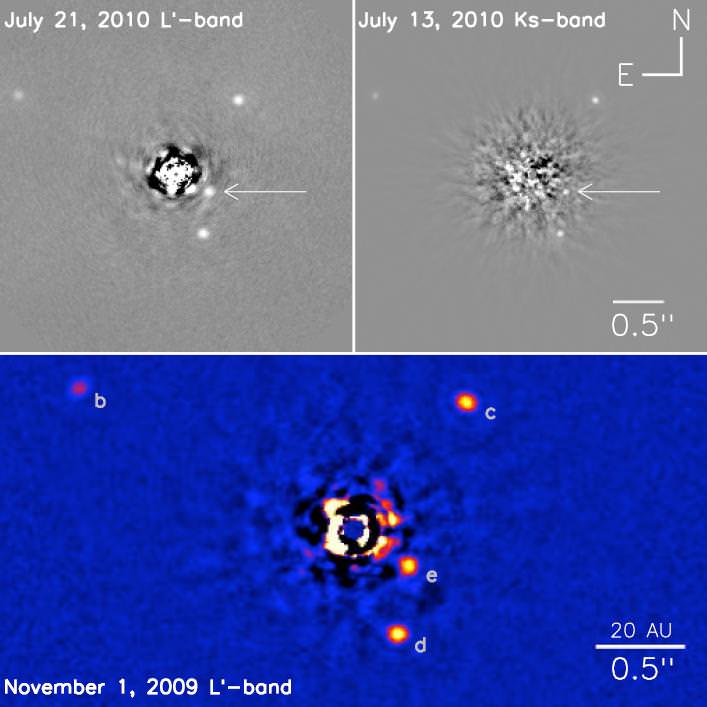
[/caption]
Among one of the first exoplanet systems imaged was HR 8799. In 2008, a team led by Christian Marois at the Herzberg Institute of Astrophysics in Canada, took a picture of the system directly imaging three giant planets. The team revisited the system in 2009 – 2010 with the Keck II telescope and discovered a fourth planet in the system.
The new planet, designated HR 8799e, orbits at a distance of 14.5 AU, making it the innermost planet in the system. The other planets all orbit at distances of >25 AU. The images were taken in the near infrared where they are most noticeable because the system is relatively young (<100 Myr) and the planets are still radiating large amounts of heat from their formation.
The youth of these planets is part of what makes them an interesting target for astronomers. There exists a controversy in the community of planetary astronomers on the formation method of large planets. One theory states that planets form from a single, monolithic collapse that creates the entire planet’s mass at one time. Another possibility is that the initial collapse forms small cores early on, but then there is substantial growth later, as the planetesimal sweeps up additional material.
The discovery of the new planet challenges both theories. Marois states, “none of [the theories] can explain the in situ formation of all four planets.” Thus, a combination of both methods may be in use in the system. Several belts of dust are also known in the system which may help astronomers determine what modes of formation were present.
In particular HR 8799e is challenging to an in situ formation because the gravitational perturbations from the parent star should disrupt the formation of large gas planets within 20-40 AU from a single formation. Instead, the new planet would likely have had to been a core collapse with subsequent accretion, or alternatively, moved to its present location via migration.
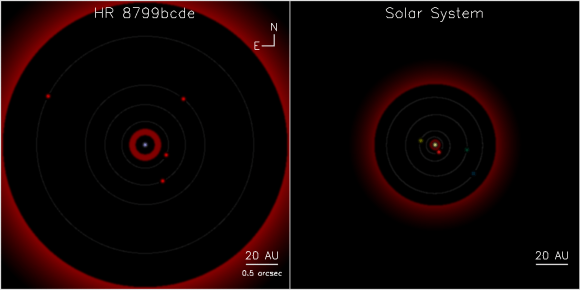
Studying systems such as this may help astronomers better understand the formation of our own solar system. The paper notes that the HR 8799 “does show interesting similarities with the Solar system with all
giant planets located past the system’s estimated snow line (~2.7 AU for the Solar system and ~6 AU for HR 8799)”. Additionally, both have debris disks beyond the outer orbits with similar temperatures.
Different methods of detecting planetary formation necessarily turn up different types of systems. Radial velocity studies detect massive, close-in planets whereas direct imaging most easily finds more distant planets. These two apparent populations represent different modes of planetary formation and for a full understanding, astronomers will need a continuous sampling that merges the two. Marois notes that we are still far from this goal as “[w]e just do not have enough exoplanets detected by direct imaging (~6 so far)” to make any conclusions besides constraints from the non-detections occurring thus far. To truly merge these two populations, astronomers will likely need to wait until more systems are discovered.
Previously, some work has been done to estimate the composition of the atmospheres of the three planets already discovered in the system. These systems have been suggested to have cloudy atmospheres for CH4 and CO. According to Marois, his team is, “planning more observations on e, but it will be hard. We might have to wait for new instruments, like the Gemini Planet Imager to do it properly.” This new instrument “will put a ‘thumb’ on the star (or what we call a coronagraph) to physically block the star light and allow ‘easy’ detection of nearby faint planets.”
While this discovery is a first, it will certainly be one of a long line of exoplanet images. Marois is obviously excited about the ability to directly image planets. I asked him what the single most important thing he wanted readers to get from this research. His response was simple, “That we now have the telescopes and instruments to SEE planets orbiting other stars – that’s really cool! The exoplanet field is still very young and we have so much to learn.”
New Earth-sized Exoplanet is in Star’s Habitable Zone
[/caption]
An enticing new extrasolar planet found using the Keck Observatory in Hawaii is just three times the mass of Earth and it orbits the parent star squarely in the middle of the star’s “Goldilocks zone,” a potential habitable region where liquid water could exist on the planet’s surface. If confirmed, this would be the most Earth-like exoplanet yet discovered and the first strong case for a potentially habitable one. The discoverers also say this finding could mean our galaxy may be teeming with prospective habitable planets.
“Our findings offer a very compelling case for a potentially habitable planet,” said Steven Vogt from UC Santa Cruz. “The fact that we were able to detect this planet so quickly and so nearby tells us that planets like this must be really common.”
Vogt and his team from the Lick-Carnegie Exoplanet Survey actually found two new planets around the heavily studied red dwarf star Gliese 581, where planets have been found previously. Now with six known planets, Gliese 581 hosts a planetary system most similar to our own. It is located 20 light years away from Earth in the constellation Libra.
The most interesting of the two new planets is Gliese 581g, with a mass three to four times that of the Earth and an orbital period of just under 37 days. Its mass indicates that it is probably a rocky planet with likely enough gravity to hold on to an atmosphere.
The planet is also tidally locked to the star, meaning that one side is always facing the star in sunlight, while the side facing away from the star is in perpetual darkness. One effect of this is to stabilize the planet’s surface climates, according to Vogt. The most habitable zone on the planet’s surface would be on the terminator, the line between shadow and light, with surface temperatures decreasing toward the dark side and increasing toward the light side.
“Any emerging life forms would have a wide range of stable climates to choose from and to evolve around, depending on their longitude,” Vogt said.
There has been debate about the other planets found previously around Gliese 581, whether they could be habitable or not. Two of them lie at the edges of the habitable zone, one on the hot side (planet c) and one on the cold side (planet d). While some astronomers still think planet d may be habitable if it has a thick atmosphere with a strong greenhouse effect to warm it up, others are skeptical. The newly discovered planet g, however, lies right in the middle of the habitable zone.
“We had planets on both sides of the habitable zone–one too hot and one too cold–and now we have one in the middle that’s just right,” Vogt said.
The researchers estimate that the average surface temperature of the planet is between -24 and 10 degrees Fahrenheit (-31 to -12 degrees Celsius). Actual temperatures would range from blazing hot on the side facing the star to freezing cold on the dark side.
If Gliese 581g has a rocky composition similar to the Earth’s, its diameter would be about 1.2 to 1.4 times that of the Earth. The surface gravity would be about the same or slightly higher than Earth’s, so that a person could easily walk upright on the planet, Vogt said.
The planet was found using the HIRES spectrometer (designed by Vogt) on the Keck I Telescope, measuring the star’s radial velocity. The gravitational tug of an orbiting planet causes periodic changes in the radial velocity of the host star. Multiple planets induce complex wobbles in the star’s motion, and astronomers use sophisticated analyses to detect planets and determine their orbits and masses.
“It’s really hard to detect a planet like this,” Vogt said. “Every time we measure the radial velocity, that’s an evening on the telescope, and it took more than 200 observations with a precision of about 1.6 meters per second to detect this planet.”
In addition to the radial velocity observations, coauthors Henry and Williamson made precise night-to-night brightness measurements of the star with one of Tennessee State University’s robotic telescopes. “Our brightness measurements verify that the radial velocity variations are caused by the new orbiting planet and not by any process within the star itself,” Henry said.
The researchers also explored the implications of this discovery with respect to the number of stars that are likely to have at least one potentially habitable planet. Given the relatively small number of stars that have been carefully monitored by planet hunters, this discovery has come surprisingly soon.
“If these are rare, we shouldn’t have found one so quickly and so nearby,” Vogt said. “The number of systems with potentially habitable planets is probably on the order of 10 or 20 percent, and when you multiply that by the hundreds of billions of stars in the Milky Way, that’s a large number. There could be tens of billions of these systems in our galaxy.”
Source: University of California – Santa Cruz
Here’s an article about abiogenesis, or the beginning of life on Earth.


